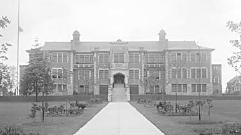
The Provincial Normal School was a publicly funded post-secondary institute, run by the Department of Education, for teacher training. Until 1956, Provincial Normal Schools operated in Vancouver and Victoria.
 The term "normal school" is derived from the French Ecole Normale Sup�rieure, which provided instruction in the "norms" or "standard practices" of teaching.
The term was adopted by teacher training schools established in the United States (the first at Lexington, Massachusetts, 1839)
and eastern Canada (Montreal, 1836; Toronto and Fredericton, 1847).
The term "normal school" is derived from the French Ecole Normale Sup�rieure, which provided instruction in the "norms" or "standard practices" of teaching.
The term was adopted by teacher training schools established in the United States (the first at Lexington, Massachusetts, 1839)
and eastern Canada (Montreal, 1836; Toronto and Fredericton, 1847).
In 1901, following many years of discussion, the first Provincial Normal School in British Columbia was opened in Vancouver. Classes commenced on 9 January 1901 and were held in the "old" Vancouver High School building (1893) located at Cambie and Dunsmuir Streets. The following year classes were held in Lord Roberts School and in 1905 the Normal School moved to the "new" Vancouver High School building (1905) at 12th and Oak. In January 1909, the Provincial Normal school moved into a new facility and its own building [shown left], located at 11th and Cambie.
The Normal School building was designed by architects Pearce & Hope. The design included Gothic Revival details such as the arched entranceway, rough granite and sandstone walls, and stained glass windows.
In 1915 a second Provincial Normal School opened in Victoria. Trainee teachers from greater Vancouver and the lower Mainland attended the Normal School in Vancouver. Students from Vancouver Island and students who were "beyond Hope" – that is, from the Upper Fraser Valley and communities in the interior of the province – enrolled in the Normal School in Victoria.
Initially, the Normal School offered a four-month programme for students who had completed Grade 11. Later the programme was expanded to two years and was designed for students who had earned their Senior Matriculation (Grade 12). In the 1920s the syllabus of the Provincial Normal School was respectably rigorous – as is evident from the Provinical Normal School curriculum, 1928-1929.
In 1956 the responsibility for provincial teacher training was transferred to The University of British Columbia. The Provincial Normal School building in Vancouver was converted into provincial government offices. The Normal School building in Victoria was utilized by Victoria College, which was affiliated with the Faculty of Education at U.B.C. (In the 1960s, the Lansdowne facilty became the Victoria School Board's Institute of Adult Education. Now called the Young Building – after Education minister Henry Esson Young (1907-1915) – the building was refurbished in 2001 and is the centre piece of Victoria's Camosun College.)
Meanwhile, the ex-Normal School building in Vancouver deteriorated and was slated for demolition on several occasions in the late 1970s and early 1980s. Fortunately, the building – and its neighbour, the former Model School – was designated a municipal heritage site on 8 July 1986. On 16 August 1989 the Normal School (and the Model School) "opened their doors to the public once again." The buildings were incorporated into an innovative commercial mall called City Square. The original interiors of the old buildings were gutted, but the exteriors were preserved and refurbished and now accommodate shops, boutiques, language schools, a modelling agency and private offices.
The City Square complex was designed by Paul Merrick Architects. It is a marvellous place. The north side of the complex looks down the hill on Cambie Street towards downtown Vancouver, and faces a small park on what was once West 10th Avenue. When you walk up the main stairs from the park and enter City Square from this side of the complex, you have the impression of walking into an old institutional building. But after you press the old fashion handle on the old style door and take a few steps into the building, you enter a dynamic, colourful, bustling complex – one that has skillfully incorporated the main features of the Normal School and Model School. The formal Normal School occupies the East Wing of the Heritage complex. The former Model School is now part of the Square�s "West Heritage Tower."